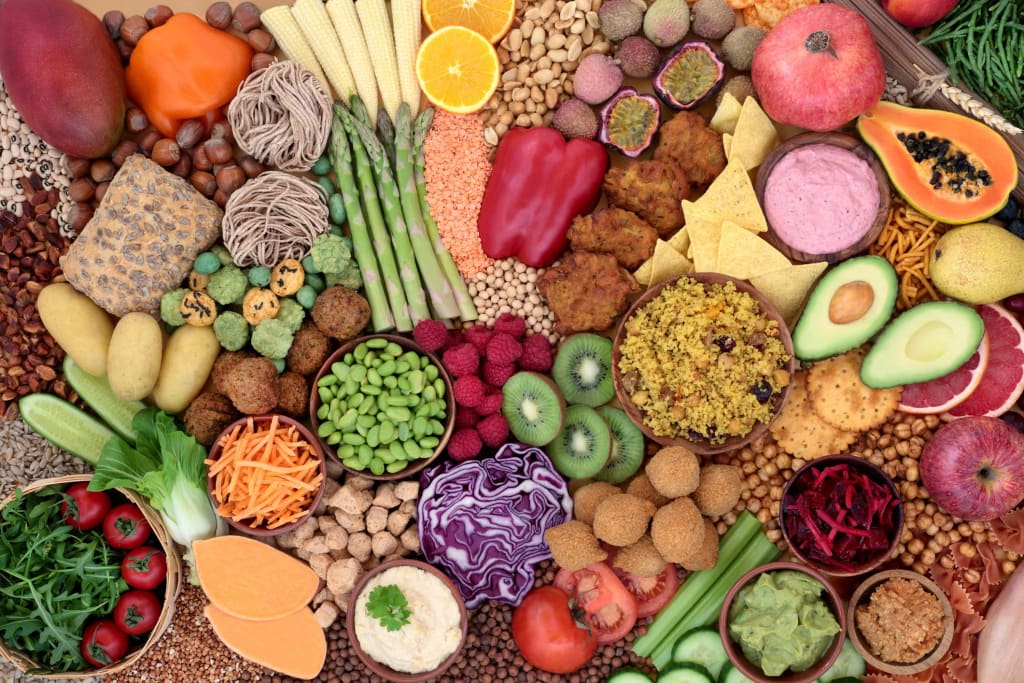How to Veggie-fy Your Life
Green Eating Made Easy

Exploring the world of vegetarianism can be a journey filled with flavors, creativity, and perhaps even a few questions along the way. It's important to remember that being a vegetarian doesn't have to mean sacrificing taste or nutrition; in fact, it can lead to a whole new culinary adventure!
If you're new to vegetarianism or just looking to incorporate more plant-based foods into your diet, you might wonder where to start. Fear not, for the possibilities are as bountiful as a farmer's market in summertime. Embrace whole grains, legumes, leafy greens, fruits, nuts, and seeds.
Whether you've been gradually cutting meat from your diet or you've recently begun giving ideas to vegetarianism, this aide — from Hetty Lui McKinnon, a cookbook writer and veggie lover of 30 years, which centers around food and wellbeing and follows a plant-forward diet at home — is intended to help with the progress.
Where do I begin?
Veg-ifying your #1 dinners:
We will more often than not cook and eat what we know, however surrendering meat doesn't mean abandoning dearest flavors. If you love chicken Parm, choose one made with mushroom or eggplant instead. If you enjoy the energetic kinds of larb, make it with mushrooms or tofu, similarly, you can make an adobo with one or the other eggplant or cauliflower, a riff on Indian spread chicken by utilizing chickpeas, and fulfill your schnitzel or breaded cutlet hankering with halloumi or tofu. Change takes time, yet it is a lot simpler if you rest on natural flavors and dishes.
Shopping smartly:
You may not begin eating lots of vegetables the day you choose to turn into a vegan — and that is Completely fine. In any case, figuring out how to cherish vegetables, and a scope of them will make your dinners fascinating. Ensure your week-by-week shopping list incorporates three or four good vegetables, similar to broccoli, green beans, peppers, summer squash, or cauliflower, alongside a bundle or two of spices, and a few mixed greens, similar to child spinach or arugula. Also, remember about frozen vegetables: Peas, corn, and spinach are amazing in simple weeknight feasts and can frequently be better and fresher from frozen. Then, at that point, add things that will loan heave — eggs, tofu, canned vegetables, pasta, noodles, and tortillas are only a couple of choices.
What sorts of ingredients would I be shopping for?
Vegetables:
Having five essential preferences — sweet, salty, sour, bitter, and umami — vegetables can take on several characteristics depending on how they’re cooked.
Take broccoli.
Eaten raw, it is mildly bitter with a grassy aftertaste. A speedy whiten in salted water uncovers its normal pleasantness, and high-heat cooking in a pan, in the oven, or on a grill about fresh edges with a natural smokiness. Treat vegetables well, and you'll be compensated in spades.
Complex carbohydrates:
Complex carbohydrates like earthy-colored rice, quinoa, grain, spelled, and oats take more time for your body to process than straightforward carbs — and cause you to feel fulfilled for longer. Pasta and noodles are simple choices for vegans; going weighty on the vegetables and lighter on the pasta can make for a supplement-rich dinner.
Lentils, chickpeas, cannellini beans, dark beans, and pinto beans — among others — can also anchor dishes and add protein. Crisp them in the stove for a delectable tidbit or salad clincher, join them with vegetables to make burger patties, stir them into a plunge, or use them as the primary fascination in soups, stews, and curries.
Tofu:
For veggie lovers, tofu isn't just a source of protein, on the other hand, it's exceptionally flexible, retaining flavors and taking on a wide range of surfaces. Try not to restrict yourself to one kind or one method for setting it up. Fresh extra-firm or firm tofu in a pan, in the oven, or air fryer; braise firm or medium-firm in a basic flavorful sauce; disintegrate and scramble different sorts with flavors; or mix smooth to make a rich sauce for noodles or pasta. Blocks of delicate, jiggly smooth tofu can likewise be finished off with a hot dressing for a fast no-cook supper, broken into stews like mapo tofu or jjigaes, or mixed into soups to add body and a rich completion.
Umami:
Umami, or savoriness, assumes a crucial part in veggie lover dishes, making everybody more extravagant and more delectable. There are numerous veggie lover wellsprings of it. Mushrooms are maybe the most notable, offering a "substantial" surface to dishes too. Others incorporate nuts and nut spread; tomato; kelp; alliums like onions, garlic, shallots, leeks, and scallions; prepared oils like chile oil, chile fresh, and salsa macha; and aged food sources like kimchi, pickles, soy sauce, miso, gochujang, doubanjiang from there, the sky is the limit.
How might I make simple meals?
On those "I don't have the foggiest idea what to cook" days, adhere to a basic recipe. As a beginning stage, consider this a "meat and three" for vegans. What's more, recall: There is no method for being vegan, in this way, for it to stick long haul, ensure it suits your way of life, storage room, and the flavors that you pine for.
Begin with a vegetable or two, cooked to your inclination: simmered, barbecued, sautéed, air-broiled, steamed, or raw.
Add a base starch or two: rice, quinoa, pasta, noodles, and vegetables.
Add a discretionary green: spinach, kale, and salad leaves.
Add a sauce: tahini, pesto, prepared oil, yogurt, vinaigrette.
Add a few additional items: Tofu, tempeh, or eggs for haul, spices for dynamic newness, nuts, and seeds for a textural crunch.
How will I know that I'm getting sufficient protein?
Government rules suggest that most grown-ups ought to consume no less than 0.36 grams of protein per pound of body weight consistently. For a typical 185-pound grown-up, this means 67 grams of protein each day.
If you incorporate no less than one serving of a high-protein food with each dinner, you'll in all probability hit that objective, said Reed Mangels, a resigned sustenance teacher and co-creator of "The Dietitian's Guide for Vegan Diets."
Beans, lentils, nuts, nut margarines, seeds, tofu, eggs, and dairy items are great sources. Furthermore, recall: The grains and vegetables on your plate contribute modest quantities of protein, as well.
What other nutrients should I be mindful of?
The greatest concern is vitamin B12, said Sudha Raj, a teacher of sustenance at Syracuse College and a deep-rooted veggie lover. B12 can prompt a large group of blood and nerve cell issues, which could bring about exhaustion, frailty, nerve issues, and mental issues like sorrow, cognitive decline, and disarray. The nutrient is found exclusively in animal-based food sources and a couple of strengthened food sources, such as healthful yeast and many plant-based milks and breakfast cereals. If you're following a vegan diet, it's really smart to take a B12 supplement, Dr. Raj said.
A modest bunch of different nutrients can come up while following a plant-based diet, including iron, calcium, vitamin D, zinc, and omega-3 unsaturated fats.
Integrating an assortment of nutrition classes into your feasts will assist you with addressing these requirements, Dr. Raj said. Beans, lentils, soy items, and entire grains are high in iron; and eating them with Vitamin C-rich food sources, similar to tomatoes, citrus natural products, cabbage, or potatoes, will upgrade your retention of iron.
If you're not consuming dairy, vegetables like kale, bok choy, and mustard greens can assist you with getting sufficient calcium. Flax seeds, chia seeds, and nuts can add zinc and omega-3 unsaturated fats — alongside a fantastic crunch — to your meals.
A few nutrients are included in plant milk, as well; simply check their nutrient labels to be certain they're great wellsprings of calcium, vitamin D, and B12. Preferably, pick an unsweetened variant, or possibly one with under 10 grams of added sugars per serving, said Matthew Landry, a nutrition scientist at the University of California, Irvine.
You can also consider taking a multivitamin as a nutritional “insurance policy,” Dr. Mangels said, though it’s usually not necessary with a well-planned diet.
How can I feel full?
If you cut meat from your dinners without adding generous plant-based food sources, you might wind up hungry, Dr. Mangels said. Fill your plate with sustaining staples that give fiber and protein, similar to beans, entire grains, tofu, and vegetables, she recommended. Also, make certain to incorporate great wellsprings of fats like nuts, seeds, avocados, yogurt, cheddar, eggs, and cooking oils.
You might find that you want to expand your serving sizes or eat all the more oftentimes to feel fulfilled, Dr. Mangels said — "nothing bad can be said about nibbling," she added.
Will following a vegan diet improve my health?
It's possible. Studies propose that embracing a reasonable plant-based diet can further develop your cholesterol levels and decrease your circulatory strain, and it might assist you with losing a touch of weight, Dr. Landry said. Arising proof proposes that it might decrease inflammation in your body and support a solid stomach microbiome, he added.
Yet, it's anything but a win big or bust recommendation. Any shift toward eating more plants and less meat — making a sautéed food with tofu rather than chicken, or supplanting half of the hamburger in your stew with beans — will most likely advantage your health, he said.
About the Creator
shanmuga priya
I am passionate about writing.
Enjoyed the story? Support the Creator.
Subscribe for free to receive all their stories in your feed. You could also pledge your support or give them a one-off tip, letting them know you appreciate their work.






Comments (1)
I'm a vegetarian and reading this made me so happy!